This month, Graihagh Jackson is getting all starry eyed over our Sun. Where did it come from? Where is it going? And what it's taught us about the universe? Plus, the mission that's taking us the closer to the Sun than we've ever been before...
In this episode

01:32 - What stardust is made of...
What stardust is made of...
with Professor Andrew Norton, Open University
Have you ever wondered what the Sun is made of? Well, Graihagh Jackson has  and so she asked Andrew Norton to talk her through it...
and so she asked Andrew Norton to talk her through it...
Graihagh - That night, it was a beautifully clear and warm evening. I was in my back garden, gazing up at the night sky and all the tiny twinkles. If I'm lucky (or unlucky depending on how you look at it) I might be able to count up to 3,000 stars...
But this is just the tip of a vast cosmic iceberg. There are 100 billion stars in the milky way... and then there are a further 100 billion galaxies.
AHH - shooting star!! That's supposed to be good luck right?
I was always told that it mean a new baby was falling to Earth (presumably from heaven?) ready to be born. But I have heard that shooting stars representing souls that have been released from purgatory and are not off on their way to heaven. Of course, they're not stars or lost souls at all, just meteors burning up as they hit the Earth's atmosphere.
It wasn't meteor that got me all starry eyed though but the idea that we're all made up of stardust.
Andrew - Absolutely, all those elements other than hydrogen, of which we're made, have indeed been formed in the cause of earlier generations of stars thrown out into space and then incorporated into the solar system and the planet earth when it formed and we are a result of that.
Graihagh - That is, of course, Andrew Norton...
Andrew - Professor of Astrophysics education at the Open University. I always say I got interested in astronomy because when I was a child, on TV we these great programmes called Dr Who and Star Trek. Now I know they're still on TV now...
Graihagh - I know Star Trek! I watched Captain Janeway is what my childhood is filled with.
Andrew - So that was it, that's what got me interested in astronomy and, bizarrely, I've managed to make a living out of it every since so it suits me fine.
Graihagh - Let's boldly go to where man has been before, on this occasion Paris in 1935 where a tutor at *ahem* L'Ecole Polytechnique by the name of Auguste Comte wrote:
"there is no conceivable means by which we shall one day determine the chemical composition of the stars"
But shortly after his death in 1957, two german physicists - one Robert Bunsen, who you may have heard of, and a Gustav Kirchhoff - proved Comte wrong.
Andrew - We don't need to go to the sun to find out what it's made of. We can look at the light which the sun emits and the key to it is that different elements emit particular patterns of light, a particular spectrum of light a particular set of wavelengths of frequencies if you like, so hydrogen gas emits light at particular frequencies that we can recognise - particular colours. So when we look at the spectrum of light from the sun or, indeed, any other star, we can see that recognisable pattern of so-called "spectral lines," that really are the fingerprint of a particular element. In fact, the gas helium was not discovered on Earth. It was discovered on the Sun. That's where the name helium comes from, the Greek word "helios," I guess, is the word for the sun.
Graihagh - Really, that's awesome!
Andrew - So back in the 19th century, I guess it was, people looked at the spectrum of the sun and saw these particular lines (spectral lines) that they didn't recognise as corresponding to any element known on Earth and that element was called helium. That's where it was first discovered in the spectrum of light from the sun and now, indeed, in other stars.
Graihagh - Now you've got me thinking back to my chemistry lessons at school and I seem to remember things like copper burns blue and sodium burns yellow. I can't remember any others but is it a bit like that?
Andrew - It is essentially that. There's a dominant colour, if you like, from particular elements but it's the detailed pattern of light that really is the key so you mentioned sodium. If you look at the spectrum of light from sodium, when sodium is in a gassier state, we see strong lines in the yellow part of the spectrum. Neon has strong lines in the red part of the spectrum - we see that in neon signs. But every element, right across the periodic table of the elements, will have it's own particular combination of spectral line.
There is another way actually that we can tell what's in the Sun and that's not by us going to the sun, it's because the sun emits particles in our direction, the so called "solar wind." And, in principle, we can detect those particles of the solar wind out in orbit around the Earth and we could in that way measure the particles directly from the Sun as well. So that's a nice way to confirm, if you like, what we're seeing in the spectra is physically there in terms of the atoms blowing off the surface of the sun.
Graihagh - Umm that's really cool. I'm just thinking a bit like literally stardust - someone can actually hold it.
Andrew - Absolutely. That's what it is - it is stardust, yes.
Graihagh - So you would attach this spectrometer to a telescope and voila but, sadly, I don't really have one of them. So can you tell me what is our Sun made of?
Andrew - Just like other stars it's pretty much three quarters hydrogen, one quarter helium, and a tiny bit of everything else.
Graihagh - Most stars are incredibly far away and we don't know a huge amount about them but what we do know, we know because of our star, the Sun - the creator of our planet and to which we owe our existence.
Andrew - I always find it amazing that deep down in the core of the sun we can figure out the temperature is 15 million degrees, so that's pretty amazing I think. Another fact about the sun: you could fit a million planet Earths inside the sun. It's about a million times the volume of the planet Earth. And what about a third fact... Umm... Well I suppose a third fact would be that the Sun is about halfway through it's life. It's about 5 billion years old and it's got about another 5 billion years to go.
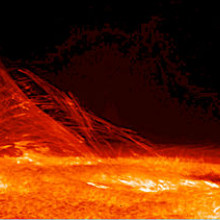
07:43 - A recipe for our Sun
A recipe for our Sun
with Dr Brendan Owens, Royal Observatory at Greenwich
The Sun is 4.6 billion years old but how did it get there? Graihagh Jackson sat 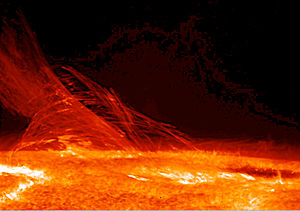 down with Brendan Owens and a bottle of washing up liquid to find out...
down with Brendan Owens and a bottle of washing up liquid to find out...
Brendan - My name is Brendan Owens and I'm an astronomer here at the Royal Observatory, Greenwich.
Graihagh - What are these beautiful pictures we're seeing right in front of us?
Brendan - This is a selection from our deep space category from our Astronomy Photographer of the Year and it's a selection of star births and star deaths.
Graihagh - There are some beautiful colours. I can see blues and yellows and reds. Very, very rich.
Breandan - It's often one of those things that it's kind of amazing, and maybe a little bit disappointing for some people sometimes is that the colour that you see in a lot of the images is what we call false colour, so it's been coloured in. Usually the astronomers take images that are actually greyscale. Those filters are corresponding to just particular energies from particular atoms so iron, carbon, oxygen - just those things and then you can chose to colour them in. Now just to avoid confusion, we don't go all creative and colour them in whatever we want; we try and stick to a palette called the "Hubble Palette" so we all recognise what the colours are.Typically in images the reds and pinks can be hydrogen and sometimes a different shade can be neon as well. If you have something like oxygen; green or blue. You can change them a little bit but, strictly speaking, trying to keep it to the different palettes that we all understand.
Graihagh - OK I'm with you now. So how do we get from these beautiful clouds of dust of atoms to what we know today as our solar system; our Sun; planets rotating around the sun?
Brendan - So if we rewind the clock back to where do we go from, something has to trigger the collapse of the gas. One cause often is a supernova explosion from another star nearby which triggers the collapse of the gas, gravity pulls in clumps of gas together and that starts to swirl and heat up. It's a bit like when you take an ice skater spinning with their arms open and then when they bring their arms in they spin faster. When you get that you're getting a squeezing and squeezing of gases. A dense gas in the middle and it gets hotter and hotter so eventually, after a few million years, the star ignites so to speak, it starts getting to a temperature where it can fuse hydrogen into helium and start the process of a new star, but you'll get a dusty doughnut around it so all the heavier elements are starting to clump together into the planets.
Graihagh - Now that we have our star, the rest of our solar system can begin to take shape... and weirdly enough, what happens next in the story of our solar system is incredibly similar to when you combine water, washing up liquid and pepper together. Join Brendan and I in our experiment -I'll give you a couple of seconds [interlude music like in elevator]... ok ready?
Brendan - What we're going to try and do is we're trying to recreate the formation of planets in our solar system. So to try and recreate this we're going to use some very easily accessible kitchen materials. I've got washing up liquid, we've got some pepper and I've got a shallow bowl of water. The first thing I'm going to have to do to recreate the idea of the gas collapsing and everything swirling around we're going to have to swirl the water first of all... I'm going to swirl this around just to get everything going and then we're going to add in our planet pieces. We'll sprinkle that in around the area...
Graihagh - Our 'planet pieces' are pepper...
Brendan - The grains by themselves are quite small but we can see they're actually clumping together to form the early planets.
Graihagh - How would that happen in real life? How would they start to creep together?
Brendan - This is one of the best bits about this demonstration is they actually do clump together before gravity can take over, before they're big enough to have enough gravitational pull to pull in material, they actually do stick, they're smashing against each other. Everything is quite hot at this time as well so things are far more malleable than we think of them today as in rocks, so more things are molten.
So they do stick together and you end up with what we call planetesimals. So really the seeds of the planets that we have today. There's another step then as well. We've still got them swirling round and we've ended up with quite a few planetesimals...
Graihagh - We have, we have... there's at least 20 or thirty there.
Brendan - And this is actually pretty good because before everything settles down into the solar system we're familiar with today, there's a lot of material flying around and smashing into each other. But before all this can happen, before you can have the great bombardment era, there's a bit of clear up job that's performed by our early star - the Sun. It's what we call a teatteri star and it's a young star that's got very powerful stellar winds. Every now and again we'll get what we call solar storms. The gas from the sun; material being ripped off; these explosions that come towards the Earth and across the solar system, but it was much worse back in the early days of our Sun.
So what we're going to do is recreate those strong stellar winds buy using washing up liquid and I'm going to put a little bit on my finger and in the experiment it's changing the surface tension of the water but it's quite magical... I hope you're ready for this...
Graihagh - I'm very ready... OK.
Brendan - So we're going to have a strong stellar wind from the young star...
Graihagh - Pop a bit of washing up liquid on your finger and dip it gently into the middle of the bowel of water and pepper... Did you see it? It's pretty quick but all the clumps of pepper have shot out from their random distribution in the water, right to the edges of the bowl. There wasn't one planetesimal left in our bowl but then how did Earth, Mars, Venus etc form?
Brendan - It's a little bit exaggerated. It's not as catastrophic because in reality you should be left behind with the biggest pieces; the most stable planetesimals, big chunks. But what it's doing in this time as the planets are forming these stellar winds are clearing out excess gas and dust. Basically they're putting a stop to any further formation.
Graihagh - When the solar wind pushed out everything, I'm assuming lots of debris got smashed more into these planetesimals and they grew bigger and bigger. So at what point would they have reached the size we know them to be?
Brendan - So we reckon we're talking about a 100 million years or so before you end up with substantially big chunks that we call the 'oligarch era'. So it's a time when you've got bigger pieces there floating around. The young stellar winds would have helped combine some of the smaller objects. But once you've got these big oligarchs, the big hitters in the solar system, then they're still flying around and they then take over to sort of finalise the last stages of forming the planets. So it's in times like this when you have collisions like the ones that formed the moon. So yes, things have settled down, the strong stellar winds have cleared out the more free floating dust and gas and left behind the big hitters that slowly slowed down, and everything cooled down and we eventually have what we consider our solar system today.
We also think that there might have been an extra gas joined in there at some point. With planets moving around the young Sun, if they're in sequence with each other. If you have say one orbit of an outside planet, it's the same as two orbits of the next planet in. If they align with each other, they give a gravitational kick to the next planet out. So we think we may actually have a lost brother of the solar system flying off - what we call a rogue planet.
Graihagh - Is that a bit like a comet? Will it come back eventually or is it just gone forever?
Brendan - It may be gone forever depending on the kick it's got. Our closest star is about four light years away but that's just in one direction so, if it went off in another direction, it's going to have a much longer journey to join up with a new planet system. There is an idea as well that planets possibly can be captured by another star system. TSo thi is really speculation - the theoretical area of things but there are theories out there that state that it is possible.
Graihagh - So is there any chance there might be a planet in our solar system that might be from another star?
Brendan - I think when we come to planets they're maybe further out. Not even planets, I should say dwarf planets. We may have captured something else from another system so there may be one of those like Pluto that doesn't belong originally to u, which would be quite, quite amazing. I think it would be quite difficult to find out if that's the case.
Graihagh - So what sort of timescale are we talking about from that initial collapse all the way to what we have today.
Brendan - Actually, relatively speaking, the early stages are in the order of up to 100 million years getting to the stage where you've got bigger pieces that can start to combine together in the solar system form today. But everything properly settled down probably about four and half billion years ago - 4.4 billion billion years ago. So that's still an incredibly long time ago that we've had that. So altogether we're talking about 10s to 100s of million years time to actually go through those stages. The trick is getting the nitty gritty detail on how things formed is quite difficult when you start off like we did at the start of the journey with one big cosmic soup from an old star but, hopefully, the latest technology has at least been able to allow us to piece together the timeline better than we ever have done before
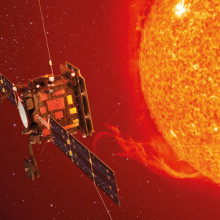
17:55 - Up close and personal with our Sun
Up close and personal with our Sun
with Dr Helen O'Brien, Imperial College London
Helen O'Brien tells Graihagh Jackson about how we're about to get closer to our 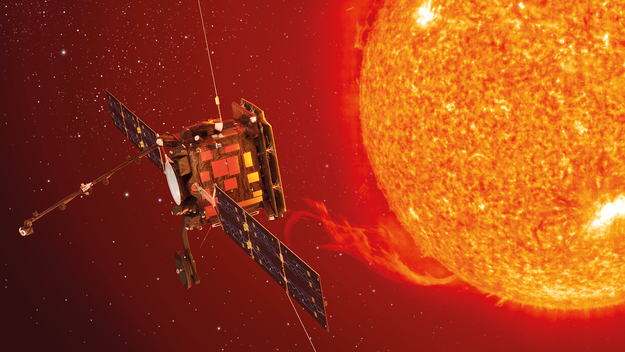 Sun than ever before thanks to ground up bones...
Sun than ever before thanks to ground up bones...
Helen - Solar orbiter is one of the European Space Agency's missions; part of their Cosmic Visions Programme. It's going to fly closer to the Sun than any spacecraft has ever gone before and it's going to have a wonderful suite of instruments which will both look at the Sun's surface through lots of telescopes in all parts of the electromagnetic spectrums, so visible light, ultraviolet light, x-rays, that kind of thing. And then it's got a range of in-situ instruments that will measure the solar wind, so the particles that stream off the sun all the time and are massively influenced by what's going on on the Sun's surface. We will actually measure those properties really close into the sun so we will be able to work out how things on the surface develop through space and how they influence space weather as it called, or what we actually see moving through space and coming off the Sun all the time.
Graihagh - And we can't do that here on Earth then?
Helen - We can't do that here on Earth. On Earth we're one astronomical unit away from the Sun and by the time the solar winds, this is the particles that stream off the sun get to us, they're kind of jumbled up. We've got fast wind and slow wind and those mixed up together and it's actually really difficult to then translate what we see here back to what's going on on the surface. The Sun rotates as well so that adds an extra complication. So if we get in really close; we're going to go to 0.28 au, so that's 28% of the Sun/Earth difference. It's just inside the orbit of Mercury. Then we actually get the new solar wind and we can really trace back then what's going on where we are, where the spacecraft is with what we see on the surface.
Graihagh - How on earth do you build something that's going to be that close to the Sun because it's got to be.. I mean the solar wind is one thing but the radiation coming off that's got to be another? So building these instruments must be quite a challenge?
Helen - It is. There's a whole lot of challenges and I think one of the main things for Solar Orbiter is dealing with the heat. You're' just that close to the Sun and mostly we rely on good spacecraft design. So the spacecraft is going to be sun pointing all the time and it basically has a huge heat shield, so a huge umbrella that it puts on the front of the spacecraft to protect it from the heat. So, essentially we'll have the hot face which looks at the Sun, which has got on the very front surface a material that's very resistant to heat, which is actually made up of ground animal bones. It's called 'solar black' and of all the inventions that man have come up, with the best heat resistant material is actually animal bone. It's basically carbon that is put on the front so, counterintuitively, the surface is black when you thought it should be shiny to reflect heat but we just don't have reflective materials that can deal with being that close to the Sun so we've got a black surface on the front.
Graihagh - It's amazing to think that all these technical revolutions, and I'm looking around your lab here and it's full of an amazing array of equipment, yet we're still going back to things like ground up animal bones to do the work for us.
Helen - It is. It's one of the wonderful things that I think about this that however much work we do, however much research we do, there's actually a lot to be discovered just in the natural world. And that's one of the reasons why we want to go and study the Sun because the Sun can tell us so much about the universe and the development of the space that we live in
Graihagh - And what Helen really wants to know if about the Sun's Magnetic field... but what is that? And why is she so keen to measure it?
Helen - So magnetic fields are really hard to explain and they're quite abstract concepts. Here on Earth we've got a magnetic field generated by the movement of the Earth's core, which is full of iron basically. Molten iron moves around and generates a field. We've got a North Pole and a South Pole and if you look at what we call field lines, which give us structure, then its the dipole that you might remember from school. So the field lines come out of the North Pole, bend around and come back in at the South Pole.
Now the area around the Earth is dominated by our own magnetic field and we call this the 'magnetosphere of the Earth'. However, the Sun also generates a magnetic field which is actually much more complicated. It goes through a cycle over 11 years and when it goes into what's known as a 'solar minimum', it has a kind of dipolar structure - one North Pole, one South Pole and the field lines look very much like they do on the Earth. But it then goes on this 11 year cycle where it moves up to what's called a 'solar maximum' and then the field is much more complicated. There's lots of local North and South Poles all over the surface of the Sun and lots of loops of field coming out. And then basically the field calms down again to another solar minimum and then at that point the field has flipped so north has become south and south has become north and that will be 11 years later.
Now the Earth's field is not quite so dynamic so we basically have one North Pole and one South Pole and we've had that for many thousands of years. However, there have been periods in the EArth's history where it's also flipped and so what was north is south and what was south is north and it's generated by the iron inside the Earth's core or it's generated by the core of the Sun. And actually how the magnetic field develops as it moves out through space tells us a lot about how energy is redistributed. And one of the great mysteries of the Sun which is why the atmosphere of the sun which is called the corona, which is what we see when we get a solar eclipse, is actually hotter than the surface of the sun. That's a really counterintuitive thing, you'd expect the surface of the Sun to be hot and as you move further it to be cooler but that's actually not the case, and we think that the reason for this is through magnetic energy heating the corona. If we try and understand this magnetic field, which is really quite complicated, but if we try and understand it then it really will tell us more about how energy is transmitted from the core of the Sun out to the atmosphere or the corona, and then out through space.
Graihagh - So tell me a little bit about your instrument? What are you working on?
Helen - So we're building the magnetometer; it measures the magnetic field. We actually put our sensor out on a long boom away from the spacecraft because everything on the spacecraft will generate magnetic fields. If you've got any kind of currents flowing, any kind of magnetic materials, they all generate magnetic fields. And the fields we want to measure are actually really tiny so the unit of magnetic field is the tesla. The tesla is one of those crazy units which is actually really, really big so there's very few things that have a field, or generate a field of 1 tesla. We deal on the surface of the Earth with microteslas, so that 10 to the minus 6 tesla, and it's about 60 microtesla on the Earth's surface. We want to go down to fields of 10, 20 nanotesla, so really really tiny, 10 to the minus 9 tesla. So the real challenge for us is trying to measure those fields accurately, and also to remove any contamination we get from the spacecraft.
Graihagh - Why do you want to measure such small fields? What is it about them that's really interesting?
Helen - The magnetic field is just a fundamental property of the solar wind and it really helps us to give order and structure to the solar wind. If you know what the magnetic field is doing, then you know the direction charged particles are moving in, for example. You can see how the solar wind and the energy from the Sun developes through space, so it really is like we use the magnetic field on Earth to help us to navigate around. The magnetic field in space really helps us navigate the solar wind we're seeing and gives it direction and order basically.
Graihagh - Can we see your instrument and what you've been working on for the last seven years, is that right?
Helen - It is yes. The instrument is actually in pieces at the moment because we've been doing some testing and we've thought of some little changes that we want to make to the electronics. So we've broken in apart and that's happening now, but I can show you the sensors and some of the electronics...
Graihagh - Wow! OK.
Helen - So here we have an electronics board which is actually our lab model. This is the same electronics that we're going to fly but it's on a circuit board where it's spaced out. So you can see we've got various probes and we're looking at the signals at various stages and trying to make sure that we eliminate any kind of background noise so that we can just measure the signal that we want, which tells us about the magnetic field.
Here I've got a sensor. So the sensor weighs about 500 grams and that actually kind of fits in the palm of your hand, and we've got two cores to measure the field in three directions.
Graihagh - And just to describe it. I mean this looks like a circuit board; it looks like something that might be in my computer at home.
Helen - That's exactly right. It's a circuit board...
Graihagh - It's even got a VGA cable or what looks like a VGA cable to go into the back of the TV.
Helen - Yes. The VGA cable is actually our sensor cable but, yes, a similar thing. The sensor gives us a very tiny signal in volts and what this electronics in front of you does is it extracts the field so we measure the magnitude of that signal in volts and its phase relative to a drive signal that we put in and that tells us about the magnitude of the field and the direction.
Graihagh - Presumably this would all be boxed up because I'm thinking it's a remarkable journey it's got to take in the first place? I mean just getting of Earth is quite a bumpy ride.
Helen - That's right. One of the big problems for Solar Orbiter is that it's quite a small spacecraft but it needs a huge Delta V to get as close as it needs to go. So it's on a really big rocket (an Atlas 5 rocket) so the vibration it experiences in launch is really quite intense. We put these electronics boxed, we make them as compact as we can. We put them inside a frame and the frame has to have a certain thickness of aluminium because we do get radiation in space and if you think a lot about what comes off the Sun: charged particles, electrons - electrons are what flow in an electric circuit. So if you mix up electrons flying in from the Sun with what's going on in your circuit, it can disrupt what's going on. So we do have a certain amount of shielding from our box which is made of aluminium. But we also use electronic components that are specially designed to resist, to be what's called radiation hard, and so to be able to deal with being bombarded with charged particles and still operate as they're supposed to.
Graihagh - So you're in the testing phase now and seeing whether it might be able to withstand these vibrations, and the radiation, and things? What's the next step - when's it going to launch?
Helen - We are working on what's called our qualification model, which is the model that we build exactly the same as the flight model but we overtest it. So we put it through horrendous vibration, thermal cycling, so we're really quite horrible to it, and at the same time we're building our flight model. So we've initiated that now and some of our boards are in population and, by the end of the year, we hope to deliver our flight model to the prime contractor's, that's the people who are making the spacecraft, that's Airbus up in Stevenage. And then two years late, October, 2018, it will launch from Cape Canaveral.
Graihagh - Are you going to be there?
Helen - I certainly hope so. That's my intention, yes.
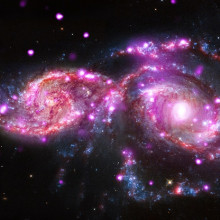
29:26 - The death of stars
The death of stars
with Professor Andrew Norton, Open University
What happens when a star reaches the end of its life? Graihagh Jackson asked 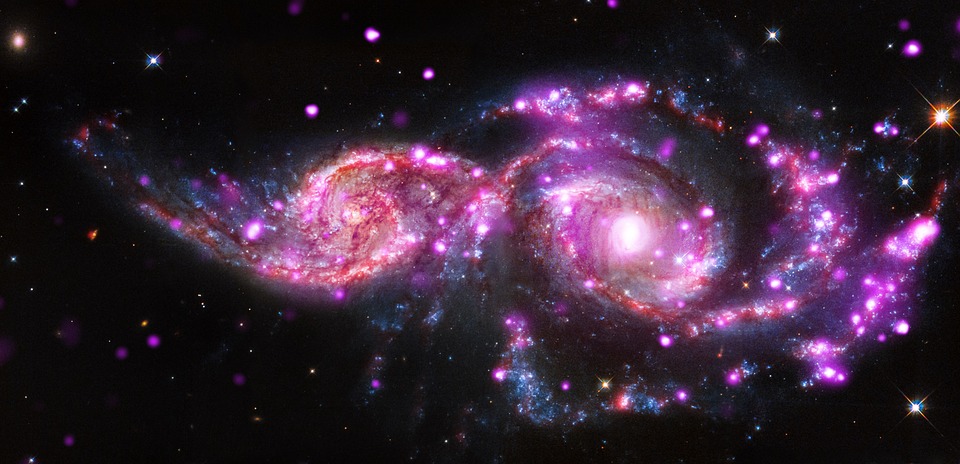 Andrew Norton about the evolution of stars like our Sun...
Andrew Norton about the evolution of stars like our Sun...
Andrew - The Sun's about halfway through it's life now and deep in the core of the Sun it's busy converting hydrogen into helium through nuclear fusion reactions. Now, in about 5 billion years time (it's just a round number), the amount of hydrogen in the core of the Sun will mostly have been used up. At that point, the Sun will expand into what we call a red giant star. At that point, it will engulf the planet Mercury, it will engulf the planet Venus. It probably won't quite engulf the planet Earth at that point because the Earth's orbit will probably move out a little bit as the Sun readjusts. But even so, that will strip away the Earth's atmosphere, boil away the oceans, and make Earth completely uninhabitable for life as we know it.
But, at that point when the Sun has become a red giant, it will readjust its internal structure, the core will become rather hotter and, at that point, it will start a new set of nuclear fusion reactions, this time converting helium into carbon. It's a nuclear reaction called the 'triple alpha process.' It's called that because an alpha particle is the nucleus of a helium atom, and if you combine together three of those, hence triple alpha, you get a nucleus of carbon. Regular carbon that we know here on Earth as coal or charcoal or something like that.
So, for a few more million years, maybe a 100 million years, something like that, the Sun will convert helium into carbon. It might also generate a little bit of oxygen in the core as well by adding on another helium nucleus to the carbon to make oxygen but, at the point, the Sun is going to run out of fuel. The outer layers of the Sun will just drift off, relatively gently into space, over the space of a few 10,000 years, something like that. And what's left behind, the remaining core of the Sun, will collapse down into a dead star really. A type of object we call a 'white dwarf'. That's what fate has in store for our Sun, as I say, in about another 5 billion years time, something like that.
Graihagh - So we've not got to worry just yet then?
Andrew - Well not just yet but, hopefully, we might have found our way to another planet by then and be living somewhere else, who knows?
Graihagh - I hope so!. White dwarfs though, I mean, what are these are they just cold balls of what, carbon?
Andrew - Yes. A star like the Sun when it sheds those outer layers, that will remove about half its mass , but the half of the mass it's left behind in the core will collapse down to something about the size of the earth. So, if you can imagine half the mass of the Sun contained in something about the size of the Earth, you can probably imagine that's pretty dense.
Graihagh - It's time for me to impress you, Andrew, with my fact because I read that when it gets to this white dwarf stage, apparently one teaspoon of that stuff is the same as one ton - it would weigh one ton.
Andrew - That sounds about right, yes. It really is going to be very dense indeed, and that's what these white dwarfs are. They're super dense object held up by something that's called 'electron degeneracy pressure,' which is a neat feature of quantum mechanics when you try to force atoms very close together. This pressure develops which holds them up and stops them collapsing and further and that's what will happen to our Sun. When it become a white dwarf, it will be this really dense ball of essentially carbon and oxygen and, when it's formed, it will be very hot because it's formed from the core of the Sun so it will initially be at temperatures millions, or at least hundreds of thousands of degrees. And then, over the course of billions of years, it will just cool and fade away ultimately becoming something we call a 'black dwarf', when it's no longer radiating any energy or heat.
Graihagh - What about stars that are bigger than our Sun? Because I understand actually our Sun is not... I mean it may seem very big given that a million Earths would fit into it, but it's actually not very big if we look at other stars around us.
Andrew - That's right. So, anything up to about 8 or 10 times the mass of the Sun, will go through pretty much the same sort of lifecycle that I've previously described ending up as this carbon/oxygen rich white dwarf. But if you've got a star that's say more than 10 times the mass of the Sun, because it's more massive, its core it hotter, and so after it's converted the helium into carbon and oxygen it can start undergoing further nuclear fusion reactions to make yet heavier and heavier elements.
So it can build up various elements through the periodic table until you get a core of that star that's composed of atoms around about iron in the periodic table. Atoms like cobalt and nickel and iron, they all sit at a particular part of the periodic table. And the thing is when you're doing nuclear fusion inside a star, as you build up towards iron, you get more energy out than you put in and that's good because that means the star can continue burning. But to go beyond iron to create yet heavier elements, you have to put in more energy than you get out and that's not a viable way of life for a star.
So, when the core of one of these massive stars is composed principally of iron it really has run out of fuel, and at that point the outer layers will fall in very rapidly, hit this sort of incompressible core, bounce out again, and that's what we call a 'supernova explosion.' When all of this outer material in the star is thrown out into space in a hugely energetic explosion and the core of the star that's left behind, this iron core, is now so dense that it collapses in on itself to become what we call a 'neutron star,' and that really is essentially is just a ball of neutrons.
Graihagh - Where the heck have all the protons and electrons gone?
Andrew - Ah, that's a good question. Essentially what happens is that because of the high densities, the high pressures there, the electrons and protons get forced together. And if you combine an electron with a proton, then you get a neutron.
Graihagh - Mmm, pretty cool. Often people talk about black holes though when stars die, so how does that happen?
Andrew - Well, we don't really know it's fair to say. But just as there's an upper limit for the mass of a white dwarf, there must be an upper limit to the mass of a neutron star. It's the so-called 'oppenheimer volkoff limit.' The trouble is, nobody knows exactly what that upper limit mass is but if you've got a core of a star remaining, then even the so-called 'neutron degeneracy pressure' that hold up a neutron star, even that is overcome. And then the material will collapse further still and there's nothing that can hold up a stellar core that's than dense and so, at that point it will, presumable, collapse into this object that we call 'a black hole,' which is as dense as we can get... an infinitely dense object left behind.
Graihagh - But it's all over just yet. Because these massive explosions, the supernovae, cause news stars to form, which brings us back to this...
Brendan - Something has to trigger the collapse of the gas. One cause often is a supernova explosion from another star nearby which trigger the collapse of the gas, gravity pulls in clumps of gas together, and that starts the...
Graihagh - And this is happening an infinite number of times, so I suggest to truly understand the nature of a star, you should listen to this podcast on repeat (it would also do wonders for my ratings!)









Comments
Add a comment